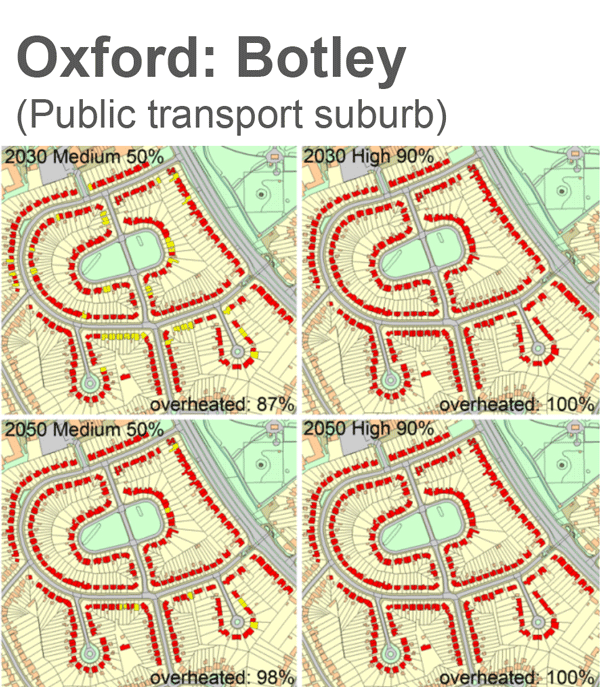ARCC assembly 2014 summary
The ARCC June assembly focused on the issues facing urban areas – from the physical impacts of weather and climate change on the fabric of cities, to the well-being of urban populations. Here we look at some of the discussions in more detail.
Adapting urban lives
It is important to consider both the human and social factors that contribute to successful climate change adaptation. The Adapting urban lives discussion examined social and behavioural research from the ARCC network and further afield.
The Liveable Cities project aims to develop realistic and radical engineering solutions to improve the well-being of city dwellers. The results of using a free-association technique to assess people’s aspirations for the future of their city were presented by Helene Joffe and Nick Smith of UCL (pdf, 1.9 MB). Their findings reflect city dwellers’ visions of a friendly, safe and connected society in the future, where green and blue spaces play an important role.
#arccassembly Q: Why isn't green infrastructure considered amongst critical infrastructure? It's function is, & not just for #ClimateChange
— Joseph Hagg (@JosephHagg) June 11, 2014
An innovative adaptation pathways model, developed in Australia, ensures that communities are involved in considering adaptation options for their specific location and sector. The Regional climate change adaptation plan for the Eyre Peninsula (Australia) also includes interesting graphics to demonstrate how plans could evolve over time, as well as showing options which have been discounted.
Excellent conference at the IET Austin court. ARCC network assembly : Urban areas as systems. #ARCC_CN
— David Lenaghan (@David_Lenaghan) June 11, 2014
Adapting our cities to environmental changes often depends on technical fixes – water management systems or air conditioning, for example. But equally as important is the human element: do residents and occupants like their adaptations, does it provide the lifestyle they want, do they know how to use the technology they’ve been given? Our communications specialist, Kay Jenkinson, takes a look at what works and what doesn’t in engaging residents in adaptation measures.
Smart adapting cities with Core Cities adaptation sub-group
Core Cities is a self-funded group of the eight largest city economies outside London.
This session looked at the city as a system within which buildings operate rather than the performance of individual buildings. Presentations examined interactions and interdependencies between buildings and the urban environment, as well as the effects of cities on human well-being.
RT @FCERMnet: Great presentation by @kitengland on planning and designing climate resilient cities! #ARCCassembly
— ARCC (@ARCC_CN) June 11, 2014
Joint working between local government and researchers is discussed on our blog – with limited budgets, co-creation is a cost-saving option that can produce unexpected benefits.
Nick Grayson, Climate change and sustainability manager for Birmingham City Council, spoke about the most likely risks to the city – flooding, high temperatures and high nitrogen dioxide concentrations (pdf, 7.7 MB). He went on to demonstrate the challenges the city faces using ‘supply and demand’ maps, and the Birmingham Green Commission Vision 2027. The city aims to be climate-resilient with a sustainable ‘green’ economy.

Birmingham 2027 – image from Birmingham’s Green Commission Carbon Roadmap report
Birmingham is the UK’s first biophilic city – one which has a deep affinity with nature. It’s a growing movement of cities from around the world which values the positive impact of the natural environment in an urban setting. It recognises the positive social impacts as well as the physical benefits of cooling green spaces.
Overheating and indoor air quality in the urban environment
Indoor environments are affected by the outdoor urban microclimate/environment – this session examined solutions to tackle overheating and indoor air quality at building, neighbourhood and city level.
Could our cities become uninhabitable? George Adams @CIBSE #ARCCassembly
— Dr Rachel Capon (@rachelcapon) June 11, 2014
The AWESOME project (Air pollution and WEather-related health impacts) looks at air quality and climate policies on air pollutant exposures and health. Through interviews with occupants of 17,000 dwellings in Greater London, Jonathan Taylor from AWESOME looked at indoor air quality and compared results with the type of building (pdf, 1.9 MB). Future work will develop a national building stock model to estimate the levels of indoor pollution for each housing type.

Potential overheating risk, Oxford suburb. SNACC project, Oxford Brookes University
RT @ARCC_CN: TfL: Today’s weather extremes will become tomorrow's averages and we will experience new extremes #ARCCassembly @TfLOfficial
— Robyn Thomas (@TheRobynThomas) June 11, 2014
The most recent report from the Adaptation Sub-Committee found that overheating in housing could contribute to premature deaths in the elderly and vulnerable population. The report calls for revised building standards to improve ventilation and reduce the impacts of temperature increases.
Our blog examines whether the focus on winter energy saving is creating summer discomfort in our urban areas.
Great presentation by @scotwaterglobal at #ARRC assembly and the use of SUDs on new developments to reduce flood risk AND improve quality
— FCERM.net (@FCERMnet) June 11, 2014

